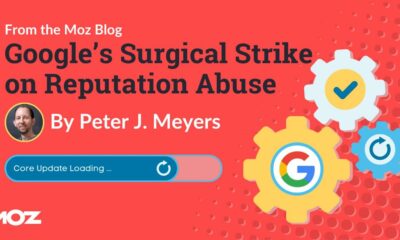SEO
A Beginner’s Guide to SEO Reporting
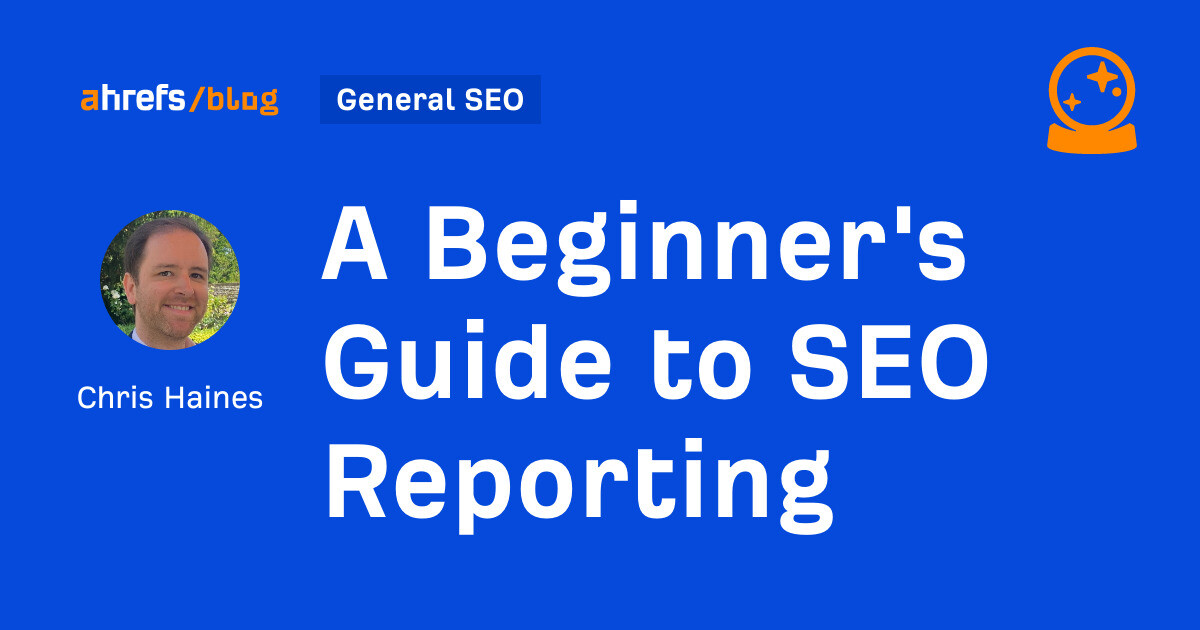
How can you prove to your boss, client, or other stakeholders that you’re not wasting your time with your SEO efforts? The best way is to share regular SEO reports with them that track the performance of your SEO campaign.
SEO reporting mixes insights, actions, data, strategy, and communication all into one document. It sounds like a lot to take in—but once you know the basics, you’ll be able to report on SEO in your sleep.
In this beginner’s article, I’ll cover the basics of reporting for SEO and show you what to include in your SEO reports.
So what makes a good SEO report?
In the past ten years, I’ve created and read many reports, and I’ve noticed one thing: the best SEO reports are data-led, actionable, and persuasive.
1. Data-led
Good SEO reports are grounded in high-quality data. You need to get as close to the “truth” as possible. The good news is that you can get all the information you need from three free tools.
2. Actionable
Reports need to lead to useful actions. Put yourself in the shoes of your stakeholders—they’ll expect you to provide an action for every insight you discover.
Here are a few common examples:
| Observation | The question you should ask |
|---|---|
| Organic traffic is down | How can we recover lost traffic? |
| Lost the number-one ranking for an important keyword | How can we get our number-one ranking back? |
| There’s a technical issue that’s impacted performance this month | What can we do to fix it? |
| Our content is not performing that well this month | Can it be improved? Does it need a rewrite? |
3. Persuasive
If you want to engage your boss or client in SEO, you must be persuasive in your SEO reporting.
Aristotle probably isn’t the first person you think can help you with SEO reporting, but an Aristotelian triangle is a good reminder of what to consider if you want to make your reports more persuasive. 

- Pathos: use logical reasoning, facts, and data to present water-tight arguments. Use SEO tools to back up your reasoning.
- Ethos: establish your credibility and ethics through results. If you work with other clients in a similar industry, you can use this to help establish your credibility. If you want to make changes on the website, share quotes from Google’s Search Essentials to show that what you are suggesting is part of SEO best practices
- Logos: make your reports tell a story. If competitors have strong performance, use it to trigger your client into action
Lastly, use high modality language. It sounds complicated, but when you write your report, remember to use higher modality words like “would” and “will” instead of lower modality words like “could” and “might” when you think something is certain or likely.
For example:
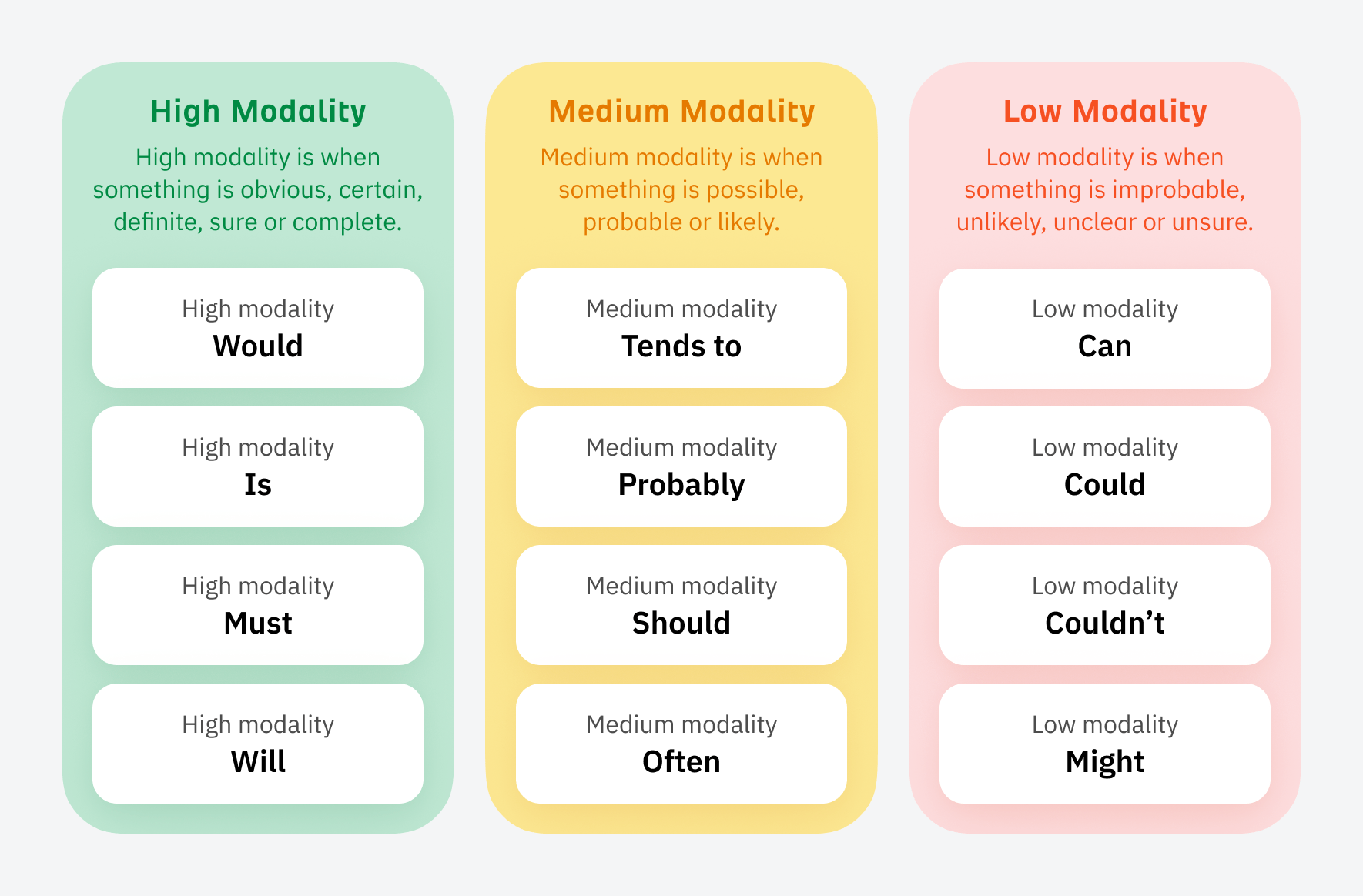

If you’ve been asked to create a regular SEO report, it’s hard to know what to include if you haven’t made one before.
SEO reports can be presented in different formats: spreadsheets, dashboards, and Word documents, but usually, the most popular format is slides. Choose whatever format you think best suits your client or boss.
To start your report, break it down into sections and determine which parts are the most relevant to the website you’re reporting on.
Here are the most important things you should include in your report:
This is the first section I would have in my report, but it’s also the last one I write (it’s hard to summarize the key points of an entire report if you haven’t yet created it).
Executive summaries are designed for senior stakeholders who don’t have time to flick through a long report. They want to know the most important points. So you need to keep this section easy to understand.
In bullet points, an executive summary summarizes the key points from the entire report.


Organic traffic and analytics data give a bird’s eye view of a website’s performance over time. This data is often visualized in a graph near the start of many SEO reports.
Most SEO reports visualize performance using GSC, GA, or Ahrefs’ Overview data. This data can be displayed as a screenshot or exported and turned into a chart.


Here’s an example of comparing Google Search Console (GSC) clicks year over year (YoY). You can use GSC when reporting on a site you own or have access to the GSC profile.
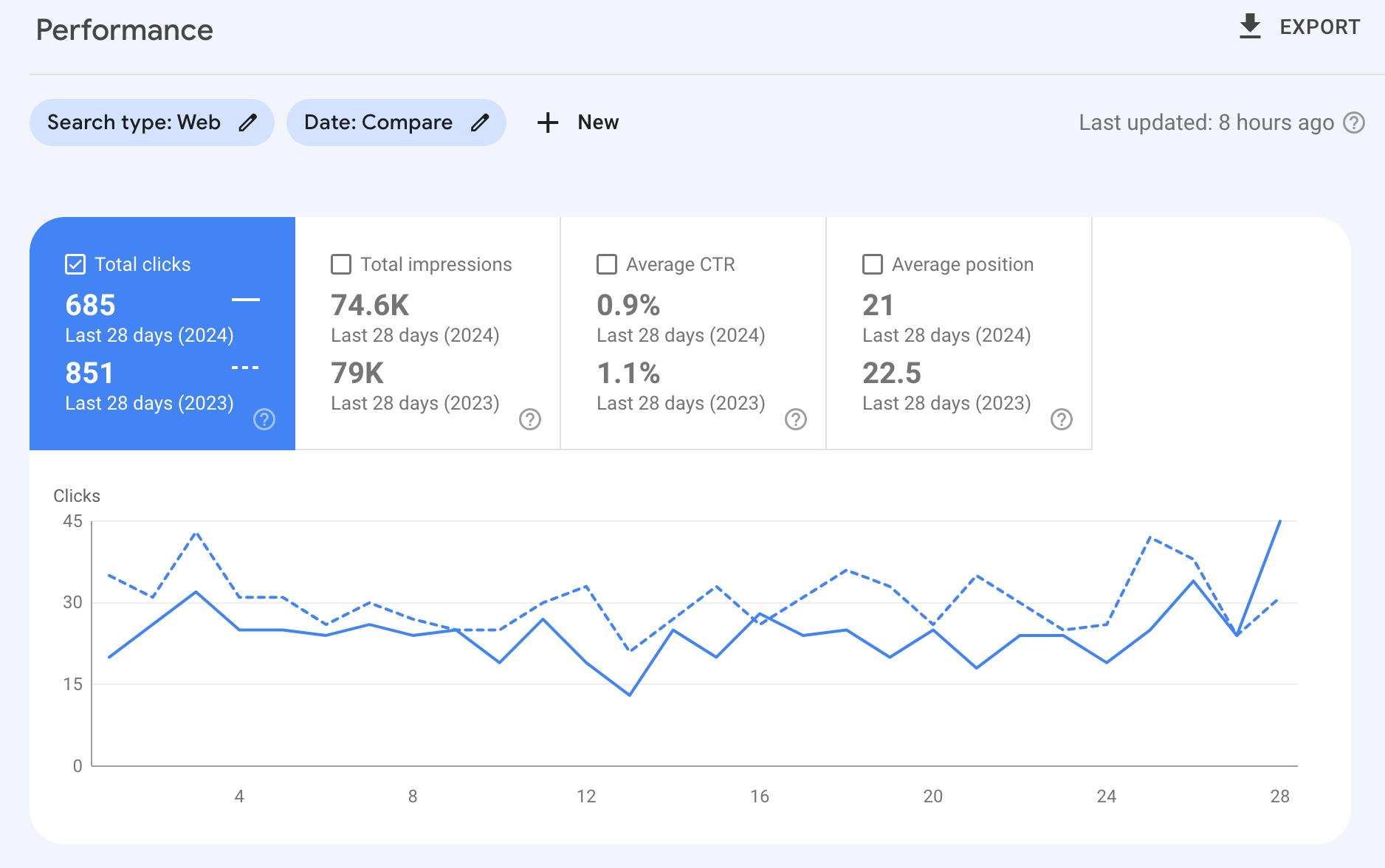

And here’s another example of Site Explorer Overview showing YoY performance:
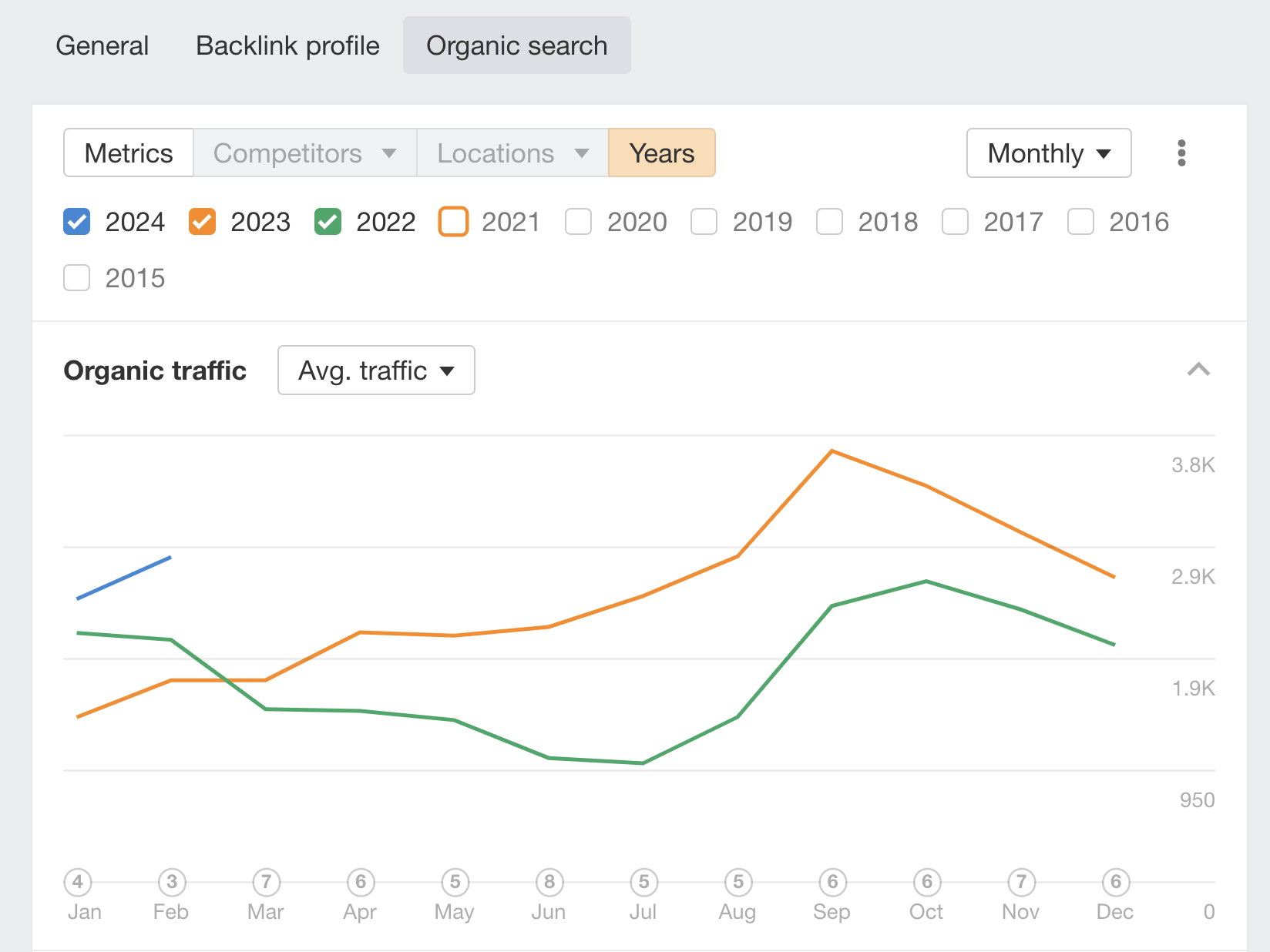

If you can’t get access to GSC or GA, then Ahrefs can show your website’s SEO performance over time. This is useful for tracking competitors’ Organic traffic performance.
Sidenote.
You can access the report for free in AWT by clicking on your project in the Dashboard, scrolling down to Performance, and toggling the Years button.
The key point you want to communicate at this stage is the website’s total performance over time. Is the movement positive, negative, or somewhere in between? And, crucially, what does this mean for the website?
Next to the chart, provide a few lines of commentary on the performance.
For example:
- Organic traffic is up 5.5% MoM but down 3% YoY
- Organic traffic was higher than expected this month. This is due to {reason}
- There was a Google algorithm update at {date} that impacted our organic search traffic
Once you’ve established the state of organic traffic, the next task is to dig into the keyword rankings to understand which keywords are driving the most traffic.
Clients or stakeholders rarely want to see all of the tracked keyword rankings for their site.
Usually, they want to see:
- Winner and loser keywords from the time period – which keywords improved and which declined?
- A keyword position spread – for example, XX keywords rank in positions 1-5, XX position rank in positions 6-10)
You can use various keyword tracking tools to do this, but you’ll need a tool like Rank Tracker to regularly track your keyword rankings.
Let’s see how we can include these elements in our report using Rank Tracker.
To find keywords that have improved:
- Head to Position
- Select Improved


To view loser keywords, repeat the process but select Declined.


Once you have exported the keywords, you can present them in a simple table and add a bullet point commentary. 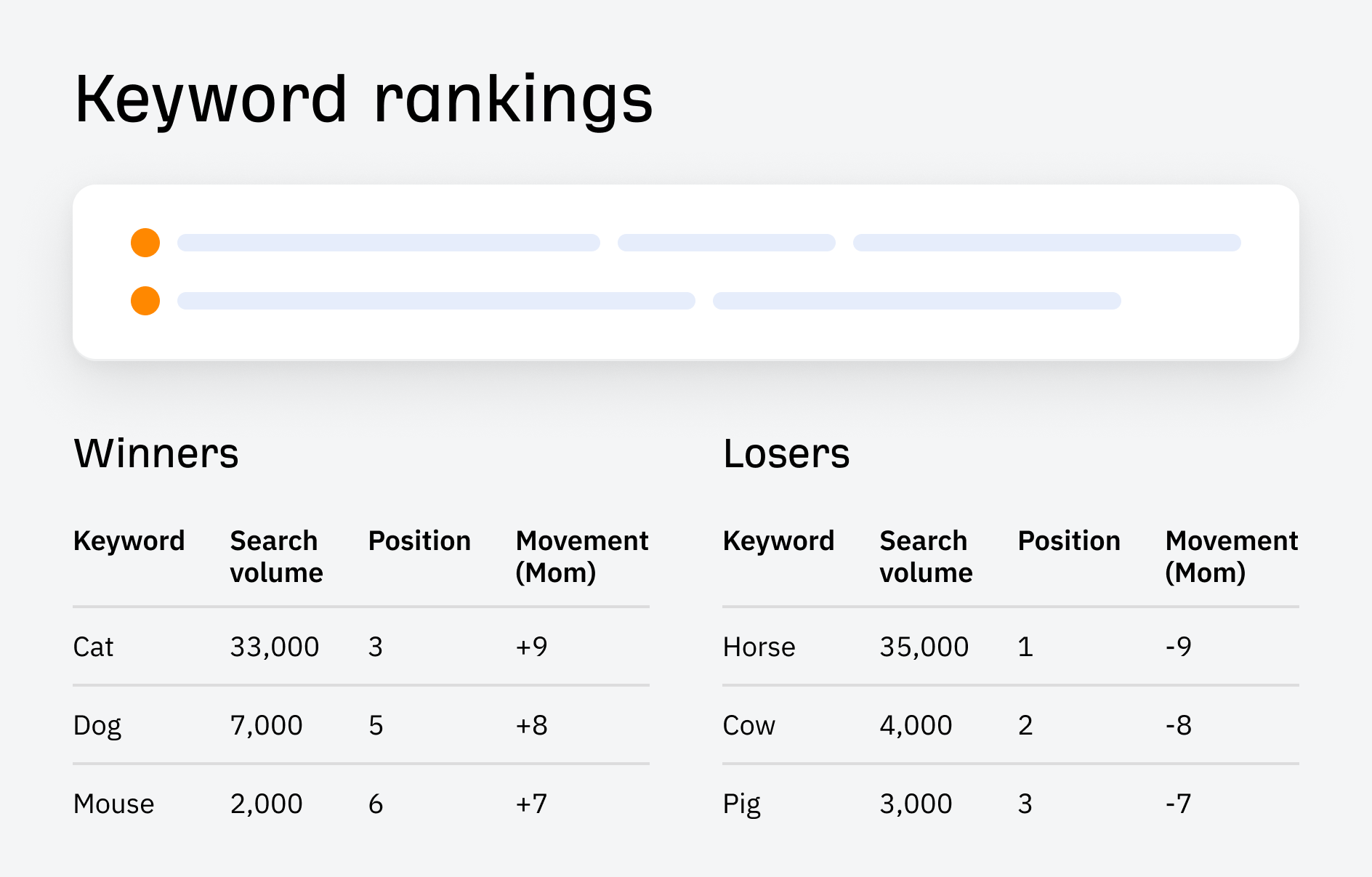

To see a keyword position spread, select a time period, then click on the Positions tab, and it will show how many keywords rank in each position.


You can visualize this in a chart over time like below, or you can take a screenshot from Ahrefs and include it in your report. 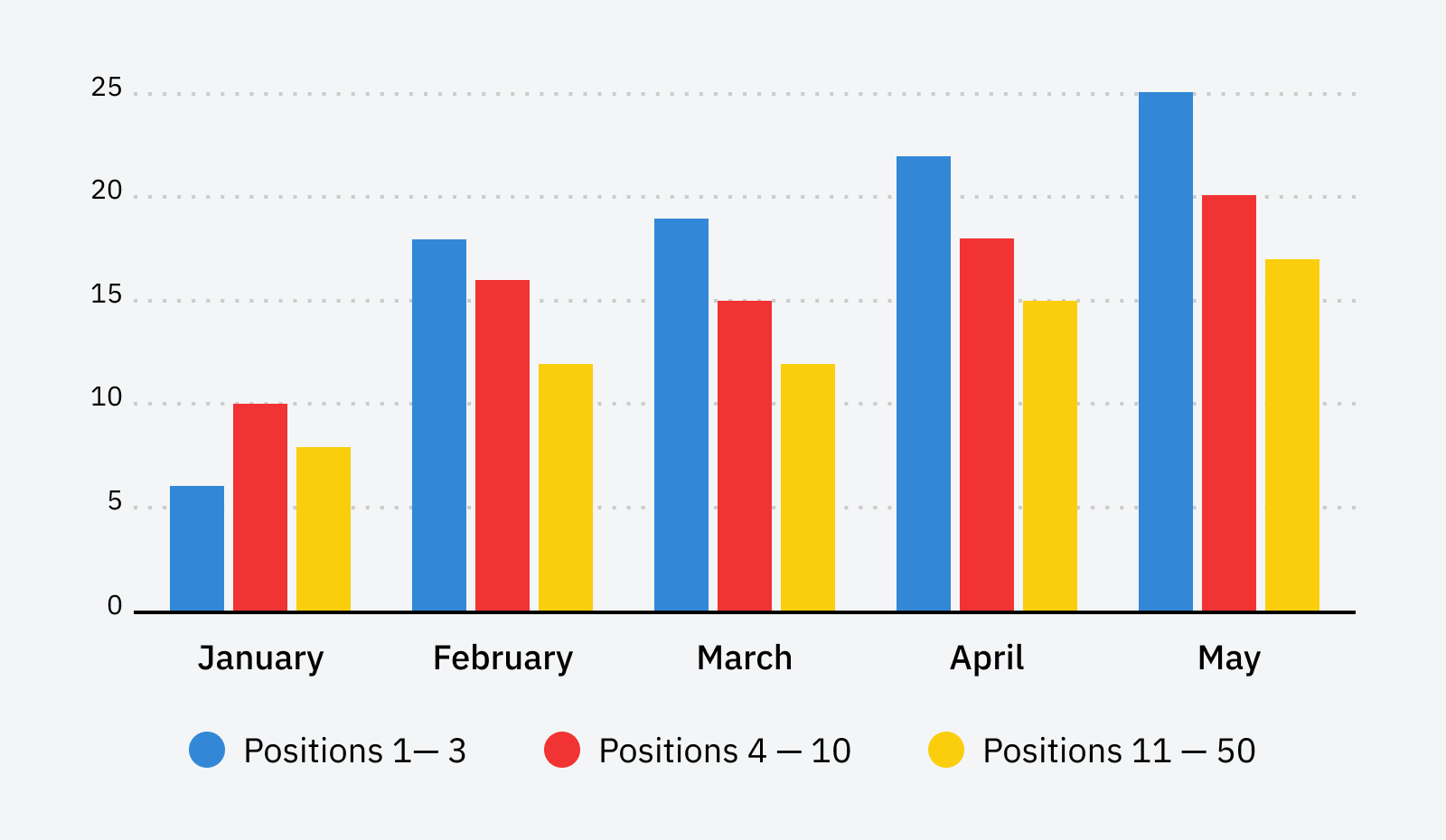

On the same dashboard, you can get the headline metrics like share of voice, average position, and SERP features.
If you’ve dabbled in SEO, you’ll know that links are a fairly big deal for SEO. So, how do you report on them in an SEO report?
SEO clients and stakeholders usually want to know two things:
- The number of external links you acquired during the time period
- The quality of those links
Luckily, Ahrefs’ Site Explorer can help you report on both elements.
But before we dive too much into the details, let’s see how we can get an overview of the last calendar month.
To do this:
- Head to Calendar on the sidebar
- Click on the Referring domains tab
- Check Dofollow
- Best links: Only
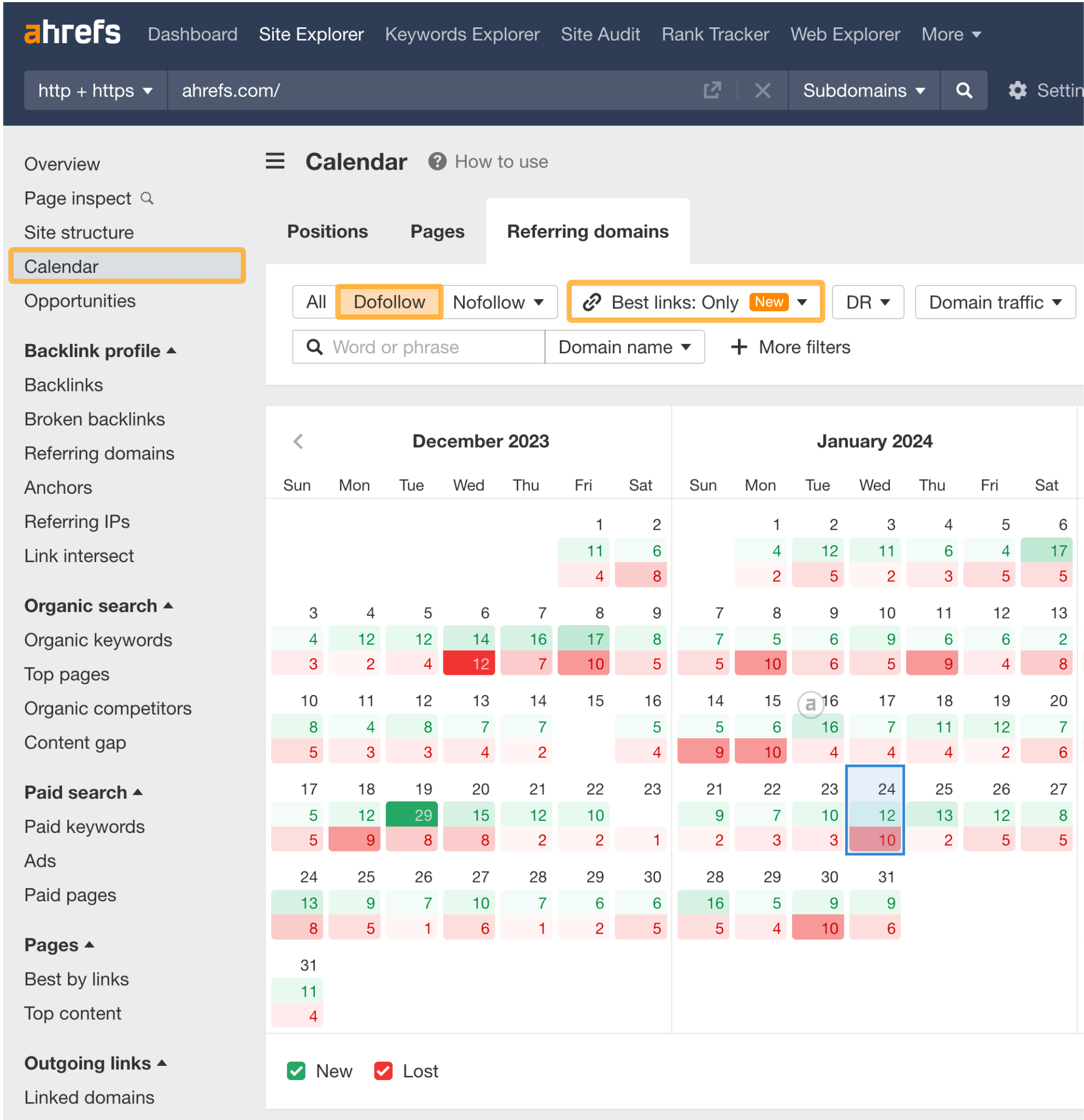

You could include a screenshot of this heatmap in your report to provide a general overview of the last time period.
To find the number of links acquired from the last calendar period, do the following in Site Explorer:
- Select Dofollow
- Select New
- Set the time period (I’ve used the last 30 days, but you can use a custom range to get the exact dates for the previous month)
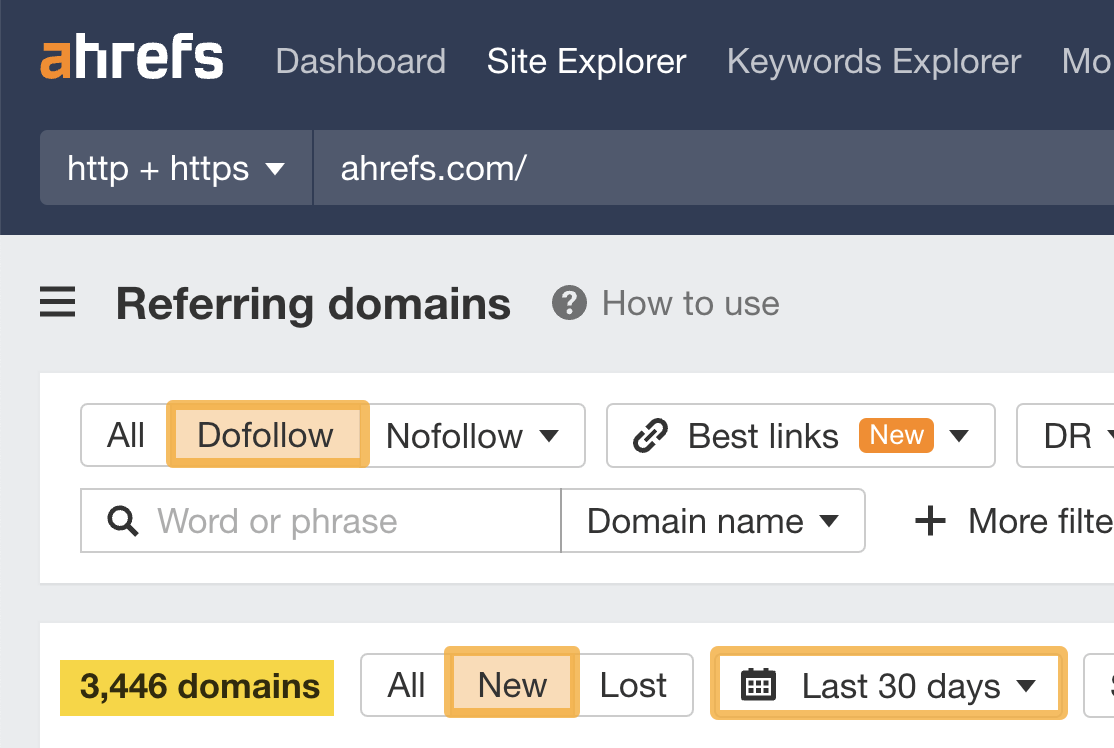

Once you’ve added these settings, you can see we’ve acquired 3,446 domains during this period.
If we want to highlight the quality of any of the links, we can do this in the report as well. Just scroll down to see all the domains.
Here’s an example of a high-quality link Ahrefs.com acquired during this period. It has a domain rating (DR) of 93. This is the type of link that would be worth sharing in an SEO report.


Once we’ve shown this is an important link, the first question stakeholders might ask is, what is the Washington Post linking to on Ahrefs?
If we click on that link, we see they’re linking to our SEO basics article.


This would be a valuable insight to share in the SEO report because it shows that this type of content is capable of earning high-quality links.
Business cases for creating new content can be hard at the best of times. By highlighting high-quality links in your SEO report, the value of content becomes more obvious to stakeholders, and they’ll be more inclined to increase investment in SEO.
As well as reporting on links you’ve acquired, it’s worthwhile to report on links you’ve lost.
Sometimes, you can lose links accidentally by making site changes. You can report on this using Ahrefs’ Broken backlinks report.
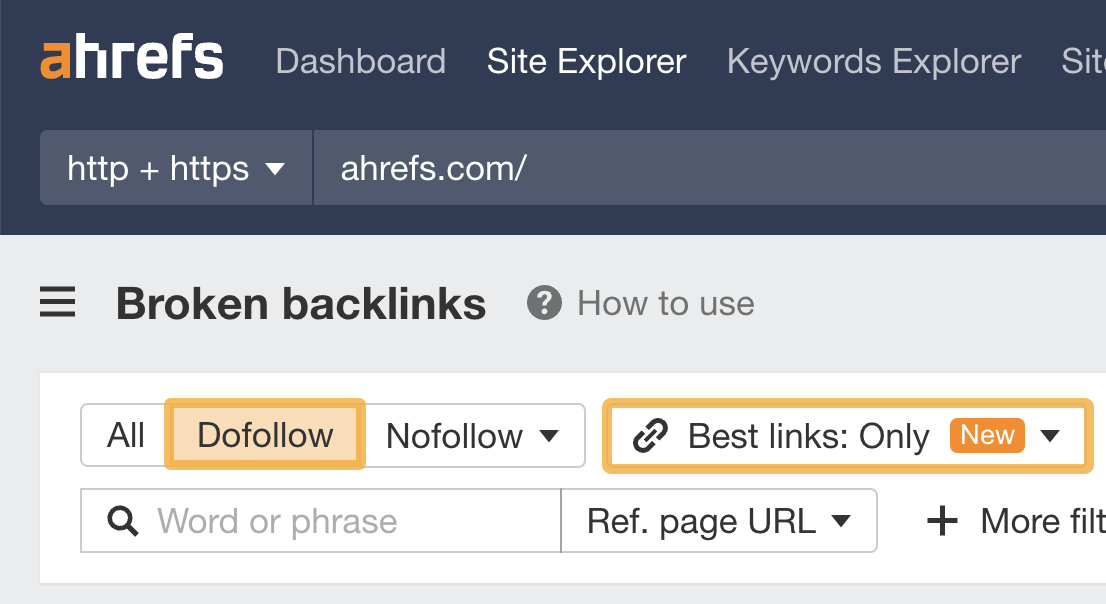

We can see that Ahrefs has a broken backlink from Neil Patel… alas.


Reporting on technical SEO is often harder than it looks. For SEOs, it’s easy to get lost in the details, but most stakeholders aren’t as interested in the details as you are and just want to know one thing: is their site in good technical health?
To answer this question, you can run a Site Audit crawl and check the website health score.
Tip
If you have access to Google Search Console, you can run a Site Audit for free on your website. Click here to get started.
Site Audit scores your website from 0-100 after the crawl based on its technical SEO health status. If the score is low, it means there are some technical issues to be fixed.
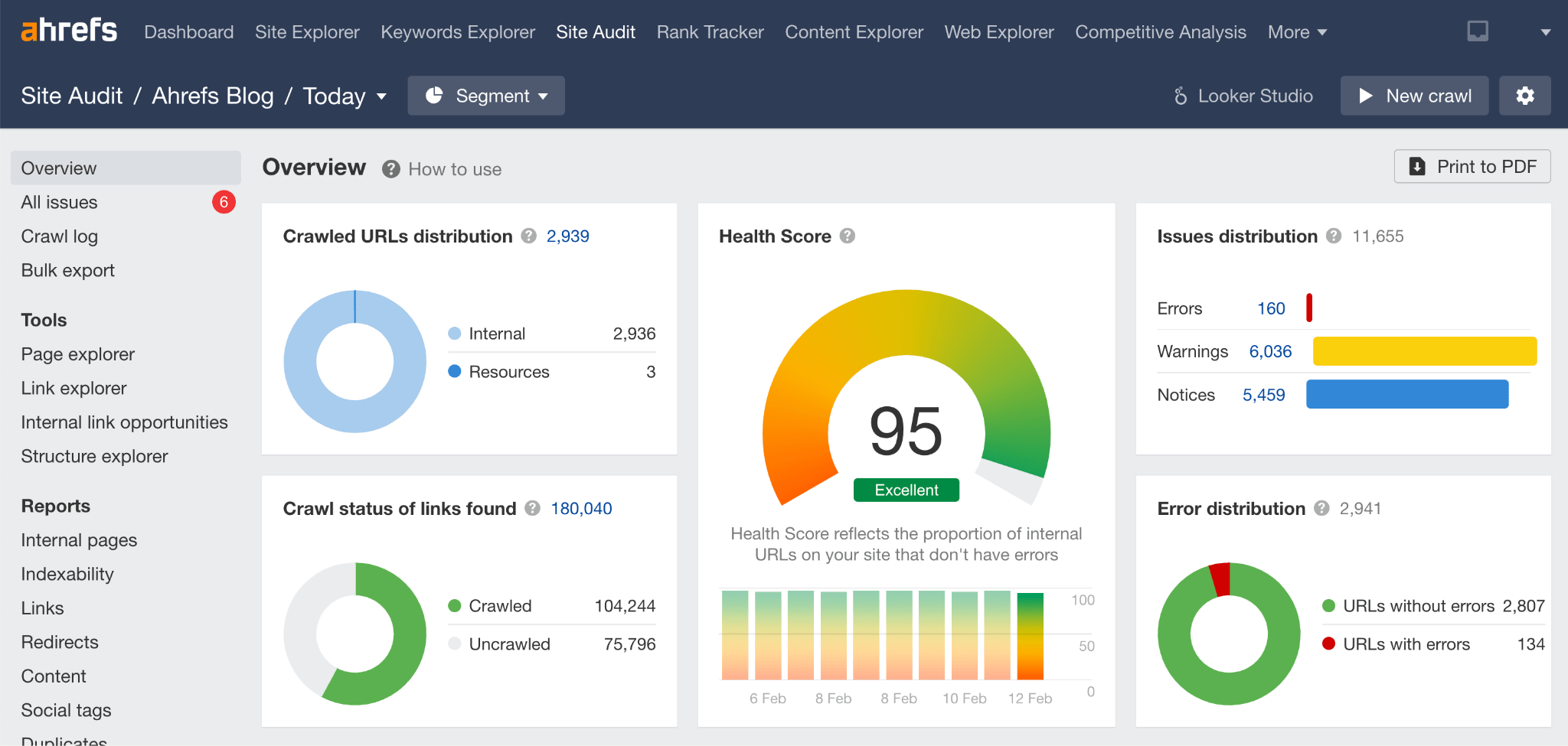

As well as running a Site Audit crawl, you can check in GSC to see if there are any technical issues with page indexing or page experience (like core web vitals or HTTPs).
Usually, if everything is fine, there isn’t any need to report on it. Unless your stakeholder or client is technically focused, keeping the technical part of your report as concise as possible is best.
If you create content regularly, assessing its performance in your SEO reporting is important—otherwise, you won’t know whether you are wasting your time.
In my experience, when it comes to content, stakeholders want to know:
- What the best-performing content was during the time period
- What organic traffic it drives
- What opportunities exist in the content space
For smaller content projects that have less than 1000 URLs, you can use Portfolios to track these keywords.
I use Portfolios myself to track the performance of my articles in Ahrefs.


Once you’ve set up your Portfolio, head to the Top pages report and click on Compare pages. On this page, you can get a good visual screenshot to share in your report of content performance, or if you want, you can Export the data and chart it yourself in a spreadsheet.
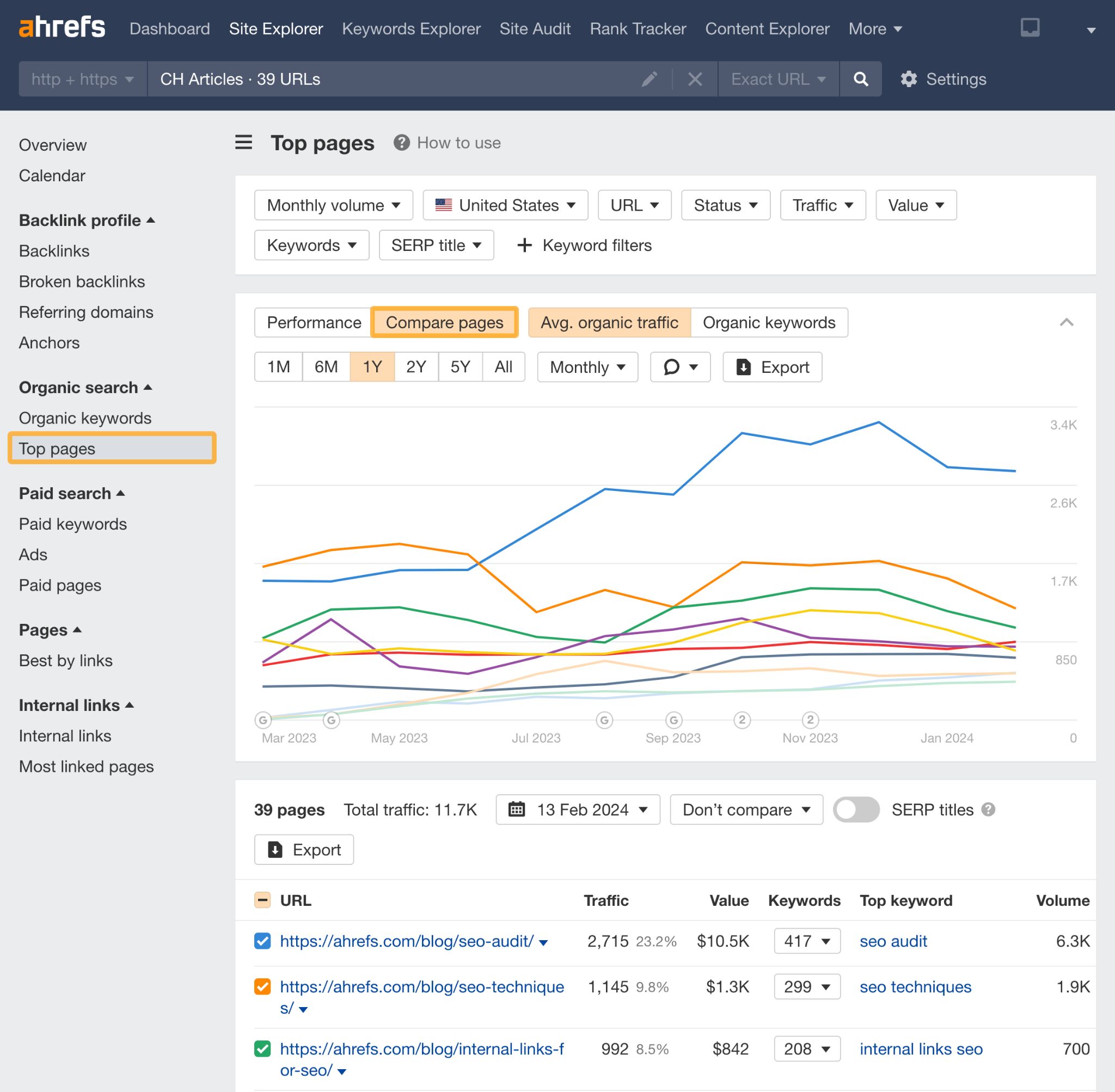

In addition to reporting on your site’s performance, it can also help to report on your competitor’s performance.
This gives stakeholders a better understanding of the digital landscape they are operating in: who they’ll compete with in SERPs, and who they should look to for inspiration.
You can do this in 30 seconds by heading to Site Explorer and typing in your competitor in the search bar.
Then click on the Organic competitors report, and you’ll get an overview of the top competitors in your space.
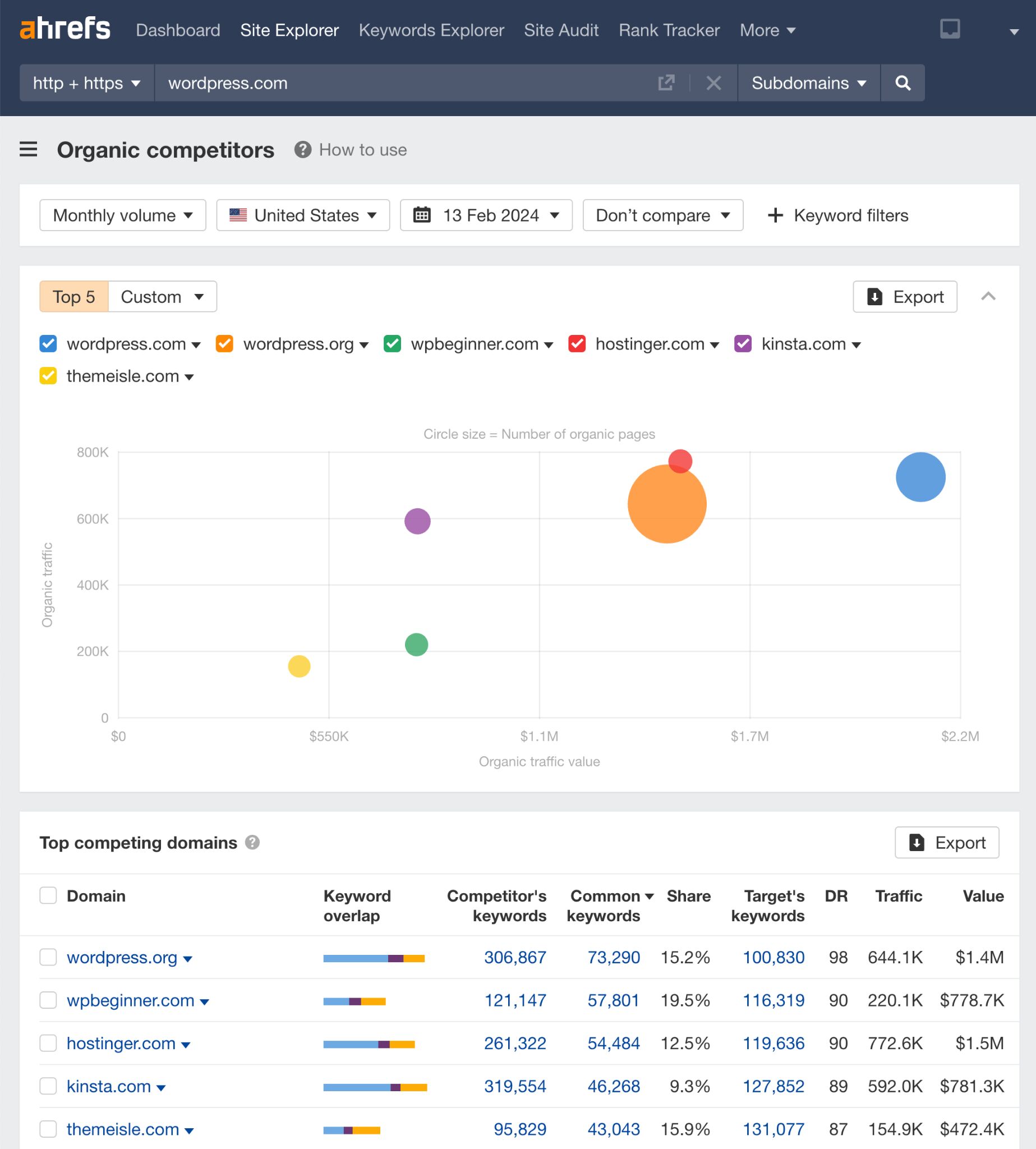

If you want to add specific competitors, you can do so using the Custom tab.


This report is helpful as it gives you a client-friendly visual representation of your competitors’ performance. But more importantly, it shows your competitors’ keywords and their overlap with your own site, helping you to make strategic SEO decisions to outrank them.
In the SEO report, I would screenshot the top half to include in my report and then export the data from the bottom half of the table to filter out the more detailed information that would interest the stakeholders.
Ahrefs makes it easy to find things to improve in its Opportunities report. This report can identify content, links, and technical opportunities in a single click.
Here’s an example of the content opportunities it can find:


- Low-hanging fruit keywords: shows keywords between positions 4-15 in Site Explorer that could be easy to rank for.
- Featured snippets: shows keywords between positions 2-8 in Site Explorer where the target doesn’t rank for a featured snippet
- Top suggestions from Content gap: shows keywords that the target’s top 10 competitors rank for, but the target doesn’t
- Content with declining traffic: shows pages with declining traffic in the last six months that could do with an update
- Pages only published once: shows old pages that have low traffic that might need an update
If you work through this report, it’s easy to spot opportunities for the website you’re reporting on that you can share with stakeholders.
Lastly, most SEO reports will share an update on the progress of their SEO campaign: the work that’s been completed so far, the next stages of the process, and the milestones you aim to hit.
The best way to do this is to share progress through an SEO roadmap Gantt chart showing your total SEO campaign.
Rather than messing around with a spreadsheet, I usually head to Canva and use one of their premade templates.
But if you want to go down the spreadsheet route, you can use our Google Sheets template.
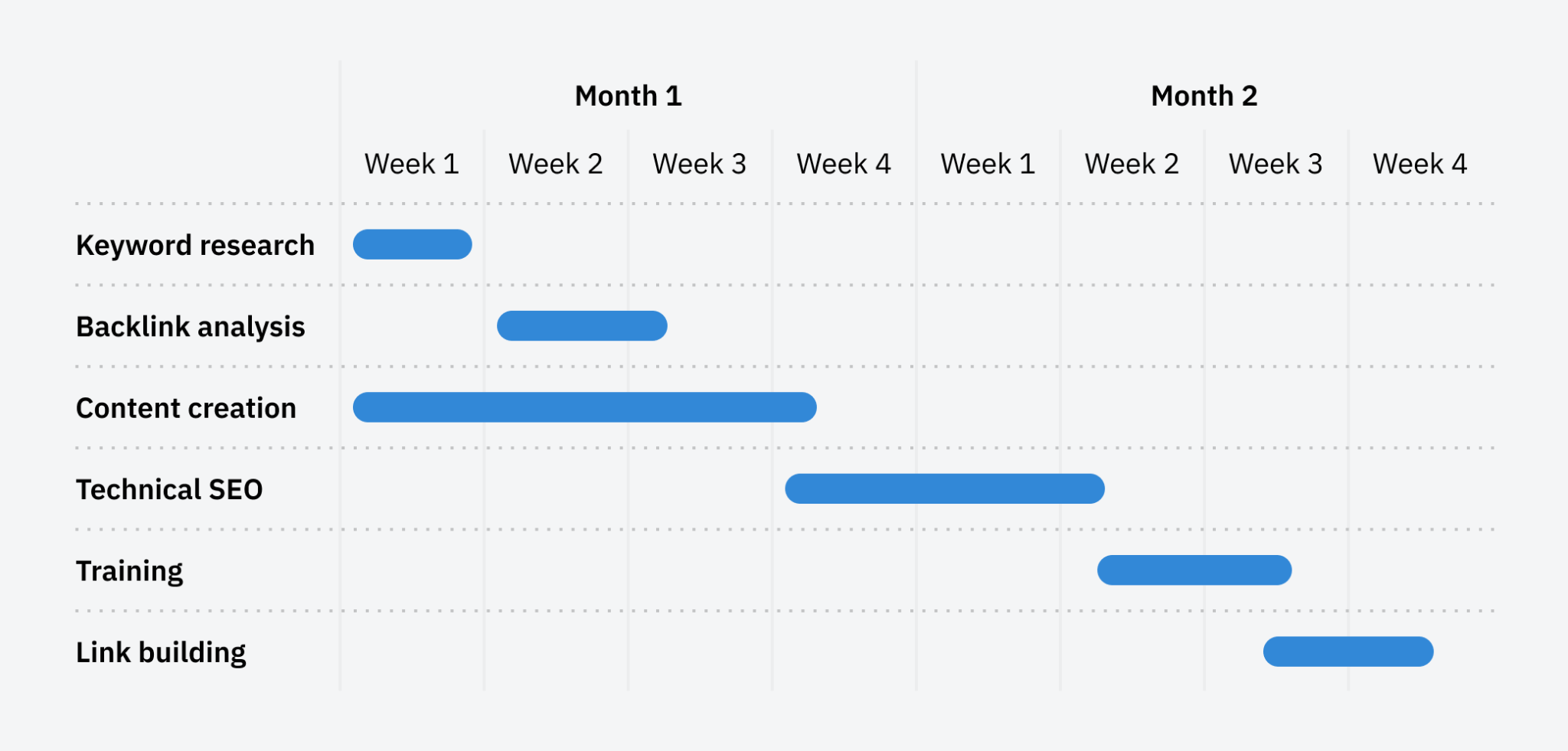

You can quickly adapt these templates for your purposes, giving stakeholders a good idea of what work has been done on the account and what is coming next.
Final thoughts
SEO reports are important as they act as your virtual paper trail, documenting your progress to the top of Google. Without them, it can be hard to prove all the work you’ve put in to get to the number one spot.
But for many clients, SEO is just one small ingredient in the marketing mix. They aren’t as interested in the minutiae of SEO as you are. So, if you want to win your clients over on the value of SEO, show them the opportunity, appeal to their emotions, and ground your decisions in industry-trusted data—like Ahrefs.
Got more questions? Ping me on X. 🙂
SEO
Google Rolls Out New ‘Web’ Filter For Search Results

Google is introducing a filter that allows you to view only text-based webpages in search results.
The “Web” filter, rolling out globally over the next two days, addresses demand from searchers who prefer a stripped-down, simplified view of search results.
Danny Sullivan, Google’s Search Liaison, states in an announcement:
“We’ve added this after hearing from some that there are times when they’d prefer to just see links to web pages in their search results, such as if they’re looking for longer-form text documents, using a device with limited internet access, or those who just prefer text-based results shown separately from search features.”
We’ve added this after hearing from some that there are times when they’d prefer to just see links to web pages in their search results, such as if they’re looking for longer-form text documents, using a device with limited internet access, or those who just prefer text-based…
— Google SearchLiaison (@searchliaison) May 14, 2024
The new functionality is a throwback to when search results were more straightforward. Now, they often combine rich media like images, videos, and shopping ads alongside the traditional list of web links.
How It Works
On mobile devices, the “Web” filter will be displayed alongside other filter options like “Images” and “News.”
If Google’s systems don’t automatically surface it based on the search query, desktop users may need to select “More” to access it.
 Screenshot from: twitter.com/GoogleSearchLiaison, May 2024.
Screenshot from: twitter.com/GoogleSearchLiaison, May 2024.More About Google Search Filters
Google’s search filters allow you to narrow results by type. The options displayed are dynamically generated based on your search query and what Google’s systems determine could be most relevant.
The “All Filters” option provides access to filters that are not shown automatically.
Alongside filters, Google also displays “Topics” – suggested related terms that can further refine or expand a user’s original query into new areas of exploration.
For more about Google’s search filters, see its official help page.
Featured Image: egaranugrah/Shutterstock
SEO
Why Google Can’t Tell You About Every Ranking Drop

In a recent Twitter exchange, Google’s Search Liaison, Danny Sullivan, provided insight into how the search engine handles algorithmic spam actions and ranking drops.
The discussion was sparked by a website owner’s complaint about a significant traffic loss and the inability to request a manual review.
Sullivan clarified that a site could be affected by an algorithmic spam action or simply not ranking well due to other factors.
He emphasized that many sites experiencing ranking drops mistakenly attribute it to an algorithmic spam action when that may not be the case.
“I’ve looked at many sites where people have complained about losing rankings and decide they have a algorithmic spam action against them, but they don’t. “
Sullivan’s full statement will help you understand Google’s transparency challenges.
Additionally, he explains why the desire for manual review to override automated rankings may be misguided.
Two different things. A site could have an algorithmic spam action. A site could be not ranking well because other systems that *are not about spam* just don’t see it as helpful.
I’ve looked at many sites where people have complained about losing rankings and decide they have a…
— Google SearchLiaison (@searchliaison) May 13, 2024
Challenges In Transparency & Manual Intervention
Sullivan acknowledged the idea of providing more transparency in Search Console, potentially notifying site owners of algorithmic actions similar to manual actions.
However, he highlighted two key challenges:
- Revealing algorithmic spam indicators could allow bad actors to game the system.
- Algorithmic actions are not site-specific and cannot be manually lifted.
Sullivan expressed sympathy for the frustration of not knowing the cause of a traffic drop and the inability to communicate with someone about it.
However, he cautioned against the desire for a manual intervention to override the automated systems’ rankings.
Sullivan states:
“…you don’t really want to think “Oh, I just wish I had a manual action, that would be so much easier.” You really don’t want your individual site coming the attention of our spam analysts. First, it’s not like manual actions are somehow instantly processed. Second, it’s just something we know about a site going forward, especially if it says it has change but hasn’t really.”
Determining Content Helpfulness & Reliability
Moving beyond spam, Sullivan discussed various systems that assess the helpfulness, usefulness, and reliability of individual content and sites.
He acknowledged that these systems are imperfect and some high-quality sites may not be recognized as well as they should be.
“Some of them ranking really well. But they’ve moved down a bit in small positions enough that the traffic drop is notable. They assume they have fundamental issues but don’t, really — which is why we added a whole section about this to our debugging traffic drops page.”
Sullivan revealed ongoing discussions about providing more indicators in Search Console to help creators understand their content’s performance.
“Another thing I’ve been discussing, and I’m not alone in this, is could we do more in Search Console to show some of these indicators. This is all challenging similar to all the stuff I said about spam, about how not wanting to let the systems get gamed, and also how there’s then no button we would push that’s like “actually more useful than our automated systems think — rank it better!” But maybe there’s a way we can find to share more, in a way that helps everyone and coupled with better guidance, would help creators.”
Advocacy For Small Publishers & Positive Progress
In response to a suggestion from Brandon Saltalamacchia, founder of RetroDodo, about manually reviewing “good” sites and providing guidance, Sullivan shared his thoughts on potential solutions.
He mentioned exploring ideas such as self-declaration through structured data for small publishers and learning from that information to make positive changes.
“I have some thoughts I’ve been exploring and proposing on what we might do with small publishers and self-declaring with structured data and how we might learn from that and use that in various ways. Which is getting way ahead of myself and the usual no promises but yes, I think and hope for ways to move ahead more positively.”
Sullivan said he can’t make promises or implement changes overnight, but he expressed hope for finding ways to move forward positively.
Featured Image: Tero Vesalainen/Shutterstock
SEO
56 Google Search Statistics to Bookmark for 2024

If you’re curious about the state of Google search in 2024, look no further.
Each year we pick, vet, and categorize a list of up-to-date statistics to give you insights from trusted sources on Google search trends.
- Google has a web index of “about 400 billion documents”. (The Capitol Forum)
- Google’s search index is over 100 million gigabytes in size. (Google)
- There are an estimated 3.5 billion searches on Google each day. (Internet Live Stats)
- 61.5% of desktop searches and 34.4% of mobile searches result in no clicks. (SparkToro)
- 15% of all Google searches have never been searched before. (Google)
- 94.74% of keywords get 10 monthly searches or fewer. (Ahrefs)
- The most searched keyword in the US and globally is “YouTube,” and youtube.com gets the most traffic from Google. (Ahrefs)
- 96.55% of all pages get zero search traffic from Google. (Ahrefs)
- 50-65% of all number-one spots are dominated by featured snippets. (Authority Hacker)
- Reddit is the most popular domain for product review queries. (Detailed)
- Google is the most used search engine in the world, with a mobile market share of 95.32% and a desktop market share of 81.95%. (Statista)


- Google.com generated 84.2 billion visits a month in 2023. (Statista)
- Google generated $307.4 billion in revenue in 2023. (Alphabet Investor Relations)
- 63.41% of all US web traffic referrals come from Google. (SparkToro)
- 92.96% of global traffic comes from Google Search, Google Images, and Google Maps. (SparkToro)
- Only 49% of Gen Z women use Google as their search engine. The rest use TikTok. (Search Engine Land)
- 58.67% of all website traffic worldwide comes from mobile phones. (Statista)
- 57% of local search queries are submitted using a mobile device or tablet. (ReviewTrackers)


- 51% of smartphone users have discovered a new company or product when conducting a search on their smartphones. (Think With Google)
- 54% of smartphone users search for business hours, and 53% search for directions to local stores. (Think With Google)
- 18% of local searches on smartphones lead to a purchase within a day vs. 7% of non-local searches. (Think With Google)
- 56% of in-store shoppers used their smartphones to shop or research items while they were in-store. (Think With Google)
- 60% of smartphone users have contacted a business directly using the search results (e.g., “click to call” option). (Think With Google)
- 63.6% of consumers say they are likely to check reviews on Google before visiting a business location. (ReviewTrackers)
- 88% of consumers would use a business that replies to all of its reviews. (BrightLocal)
- Customers are 2.7 times more likely to consider a business reputable if they find a complete Business Profile on Google Search and Maps. (Google)
- Customers are 70% more likely to visit and 50% more likely to consider purchasing from businesses with a complete Business Profile. (Google)
- 76% of people who search on their smartphones for something nearby visit a business within a day. (Think With Google)
- 28% of searches for something nearby result in a purchase. (Think With Google)
- Mobile searches for “store open near me” (such as, “grocery store open near me” have grown by over 250% in the last two years. (Think With Google)
- People use Google Lens for 12 billion visual searches a month. (Google)
- 50% of online shoppers say images helped them decide what to buy. (Think With Google)
- There are an estimated 136 billion indexed images on Google Image Search. (Photutorial)
- 15.8% of Google SERPs show images. (Moz)
- People click on 3D images almost 50% more than static ones. (Google)
- More than 800 million people use Google Discover monthly to stay updated on their interests. (Google)
- 46% of Google Discover URLs are news sites, 44% e-commerce, 7% entertainment, and 2% travel. (Search Engine Journal)
- Even though news sites accounted for under 50% of Google Discover URLs, they received 99% of Discover clicks. (Search Engine Journal)


- Most Google Discover URLs only receive traffic for three to four days, with most of that traffic occurring one to two days after publishing. (Search Engine Journal)
- The clickthrough rate (CTR) for Google Discover is 11%. (Search Engine Journal)
- 91.45% of search volumes in Google Ads Keyword Planner are overestimates. (Ahrefs)
- For every $1 a business spends on Google Ads, they receive $8 in profit through Google Search and Ads. (Google)
- Google removed 5.5 billion ads, suspended 12.7 million advertiser accounts, restricted over 6.9 billion ads, and restricted ads from showing up on 2.1 billion publisher pages in 2023. (Google)
- The average shopping click-through rate (CTR) across all industries is 0.86% for Google Ads. (Wordstream)
- The average shopping cost per click (CPC) across all industries is $0.66 for Google Ads. (Wordstream)
- The average shopping conversion rate (CVR) across all industries is 1.91% for Google Ads. (Wordstream)
- 58% of consumers ages 25-34 use voice search daily. (UpCity)
- 16% of people use voice search for local “near me” searches. (UpCity)
- 67% of consumers say they’re very likely to use voice search when seeking information. (UpCity)
- Active users of the Google Assistant grew 4X over the past year, as of 2019. (Think With Google)
- Google Assistant hit 1 billion app installs. (Android Police)
- AI-generated answers from SGE were available for 91% of entertainment queries but only 17% of healthcare queries. (Statista)
- The AI-generated answers in Google’s Search Generative Experience (SGE) do not match any links from the top 10 Google organic search results 93.8% of the time. (Search Engine Journal)
- Google displays a Search Generative element for 86.8% of all search queries. (Authoritas)


- 62% of generative links came from sources outside the top 10 ranking organic domains. Only 20.1% of generative URLs directly match an organic URL ranking on page one. (Authoritas)
- 70% of SEOs said that they were worried about the impact of SGE on organic search (Aira)
Learn more
Check out more resources on how Google works:
-

 PPC7 days ago
PPC7 days agoHow the TikTok Algorithm Works in 2024 (+9 Ways to Go Viral)
-

 SEO6 days ago
SEO6 days agoHow to Use Keywords for SEO: The Complete Beginner’s Guide
-

 MARKETING7 days ago
MARKETING7 days agoHow To Protect Your People and Brand
-

 MARKETING4 days ago
MARKETING4 days agoAdvertising on Hulu: Ad Formats, Examples & Tips
-

 MARKETING5 days ago
MARKETING5 days agoUpdates to data build service for better developer experiences
-

 MARKETING1 day ago
MARKETING1 day ago18 Events and Conferences for Black Entrepreneurs in 2024
-

 MARKETING6 days ago
MARKETING6 days agoThe Ultimate Guide to Email Marketing
-
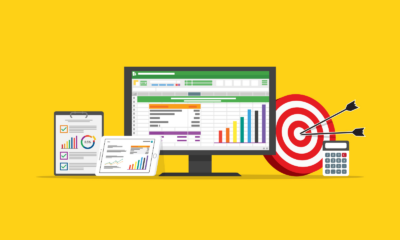
 SEO7 days ago
SEO7 days agoAutomate Multi-Site Reporting With Google Sheets And GSC API


